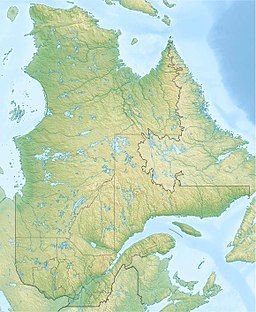
Hydro-Québec is a Canadian Crown corporation public utility headquartered in Montreal, Quebec. It manages the generation, transmission and distribution of electricity in Quebec, as well as the export of power to portions of the Northeast United States. More than 40 percent of Canada’s water resources are in Quebec and Hydro-Québec is the fourth largest hydropower producer in the world.

The James Bay Project refers to the construction of a series of hydroelectric power stations on the La Grande River in northwestern Quebec, Canada by state-owned utility Hydro-Québec, and the diversion of neighbouring rivers into the La Grande watershed. It is located between James Bay to the west and Labrador to the east, and its waters flow from the Laurentian Plateau of the Canadian Shield. The project is one of the largest hydroelectric systems in the world. It has cost upwards of US$20 billion to build and has an installed generating capacity of 15.244 GW, at the cost of 7,000 square miles of Cree hunting lands. It has been built since 1974 by James Bay Energy (SDBJ) for Hydro-Québec.

The Rupert River is a river in Quebec, Canada. From its headwaters in Lake Mistassini, the largest natural lake in Quebec, it flows 556 kilometres (345 mi) west into Rupert Bay on James Bay. The Rupert drains an area of 43,400 square kilometres (16,800 sq mi).

The Eastmain River, formerly written East Main, is a river in west central Quebec. It rises in central Quebec and flows 800 km (500 mi) west to James Bay, draining an area of 46,400 km2 (17,900 sq mi). The First Nations Cree village of Eastmain is located beside the mouth.
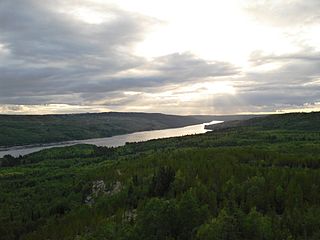
La Grande River is a river in northwestern Quebec, Canada, rising in the highlands of the north-central part of the province and flowing roughly 900 km (560 mi) west to its drainage at James Bay. It is the second-longest river in the province, surpassed only by the Saint Lawrence River.

The Mactaquac Dam is an embankment dam used to generate hydroelectricity in Mactaquac, New Brunswick. It dams the waters of the Saint John River and is operated by NB Power with a capacity to generate 670 megawatts of electricity from 6 turbines; this represents 20 percent of New Brunswick's power demand.
The Shoalhaven Scheme is a dual-purpose water supply and Pumped-storage Hydroelectricity scheme located on the South Coast region of New South Wales, Australia.

The Robert-Bourassa generating station, formerly known as La Grande-2 (LG-2), is a hydroelectric power station on the La Grande River that is part of Hydro-Québec's James Bay Project in Canada. The station can generate 5,616 MW and its 16 units were gradually commissioned between 1979 and 1981. Annual generation is in the vicinity of 26500 GWh.

The Annapolis Royal Generating Station was a tidal power generating station in the Bay of Fundy in Nova Scotia, Canada. When operational, it was the only tidal generating station in North America and was one of the few in the world. Located upstream of Annapolis Royal, Nova Scotia, it generated about 30 million kilowatt hours per year, enough for 4500 houses. Peak output was 20 megawatts.
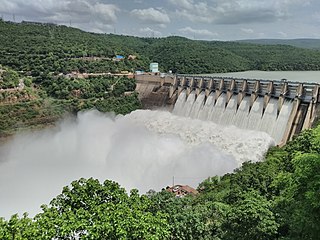
The Srisailam Dam is constructed across the Krishna River in Nandyal district, Andhra Pradesh and Nagarkurnool district, Telangana near Srisailam temple town and is the 2nd largest capacity working hydroelectric station in India.
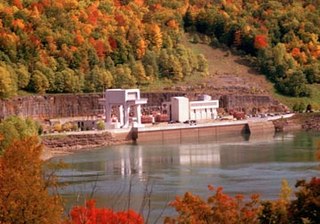
The Blenheim–Gilboa Pumped Storage Power Station is a pumped-storage hydroelectricity plant in the Catskill Mountains of New York State. The plant is part of the New York Power Authority, and can generate over 1,100 megawatts (1,500,000 hp) of electricity. It is used daily to cover peak demand. There are two reservoirs that are involved in the project, both with a capacity of 5 billion US gallons (19,000,000 m3); one at the foot of Brown Mountain in the Schoharie Valley, and another one at the top of the mountain. The power station has an accumulated capacity of about 12,000 megawatt-hours (43,000 GJ) after storing up to 17,000 megawatt-hours (61,000 GJ).

Run-of-river hydroelectricity (ROR) or run-of-the-river hydroelectricity is a type of hydroelectric generation plant whereby little or no water storage is provided. Run-of-the-river power plants may have no water storage at all or a limited amount of storage, in which case the storage reservoir is referred to as pondage. A plant without pondage is subject to seasonal river flows, so the plant will operate as an intermittent energy source. Conventional hydro uses reservoirs, which regulate water for flood control, dispatchable electrical power, and the provision of fresh water for agriculture.
According to the International Hydropower Association, Canada is the fourth largest producer of hydroelectricity in the world in 2021 after the United States, Brazil, and China. In 2019, Canada produced 632.2 TWh of electricity with 60% of energy coming from Hydroelectric and Tidal Energy Sources).
Hydro-Québec is a government-owned public utility established in 1944 by the Government of Quebec. The company is in charge of the generation, transmission and distribution of electricity across Quebec. Its head office is located in Montreal.

The Cruachan Power Station is a pumped-storage hydroelectric power station in Argyll and Bute, Scotland, UK. The scheme can provide 440 MW of power and produced 705 GWh in 2009.
The Ranganadi Dam is a concrete-gravity diversion dam on the Ranganadi River in Arunachal Pradesh, India which serves a run-of-the-river scheme.
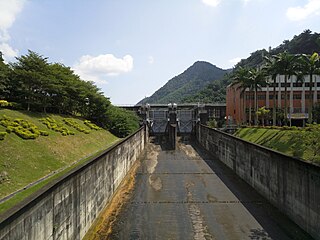
The Minghu Dam (Chinese: 明湖水壩; pinyin: Mínghú Shuǐbà, renamed the Takuan Dam, is a concrete gravity dam on the Shuili River located 7 km north of Shuili Township in Nantou County, Taiwan. The reservoir formed by the dam serves as the lower reservoir for the Minhu Pumped Storage Hydro Power Station. Sun Moon Lake serves as the upper reservoir.

The Vianden Pumped Storage Plant is located just north of Vianden in Diekirch District, Luxembourg. The power plant uses the pumped-storage hydroelectric method to generate electricity and serves as a peaking power plant. Its lower reservoir is located on the Our River, bordering Germany, and the upper is elevated above on the nearby Saint Nicholas Mountain. Construction on the plant began in 1959 and the first pump-generators were commissioned in 1962. A tenth pump-generator was installed in 1976 bringing the plant's installed generating capacity to 1,096 megawatts (1,470,000 hp). The plant generates an average of 1,650 gigawatt-hours (5,900 TJ) annually but of course consumes even more. Generally the efficiency of this energy storage method is around 70–80%. The plant is owned by Société électrique de l'Our and RWE. Construction on an eleventh pump-generator began in 2010 and it is expected to be commissioned in 2013, which will bring the plant's installed capacity to 1,296 megawatts (1,738,000 hp).

The Nemiscau River is a river flowing in the municipality of Baie-James, an administrative region of Nord-du-Québec, in Quebec, Canada.
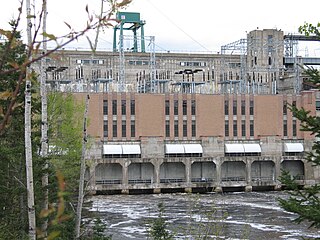
The Rapide-Blanc generating station is a hydroelectric facility, comprising a reservoir, a dam and a hydroelectric plant. It is located on the Saint-Maurice River about sixty kilometres (37 mi) north of the city of La Tuque, in Quebec, in Canada. Built between 1930 and 1934 by the Shawinigan Water & Power Company (SWPC), it is the third hydroelectric facility on this river. The plant has been operated by Hydro-Québec since it was acquired from the SWPC in 1963, as part of the nationalisation of electric power companies in Quebec. The plant has a rated power of 204 megawatts (274,000 hp).

